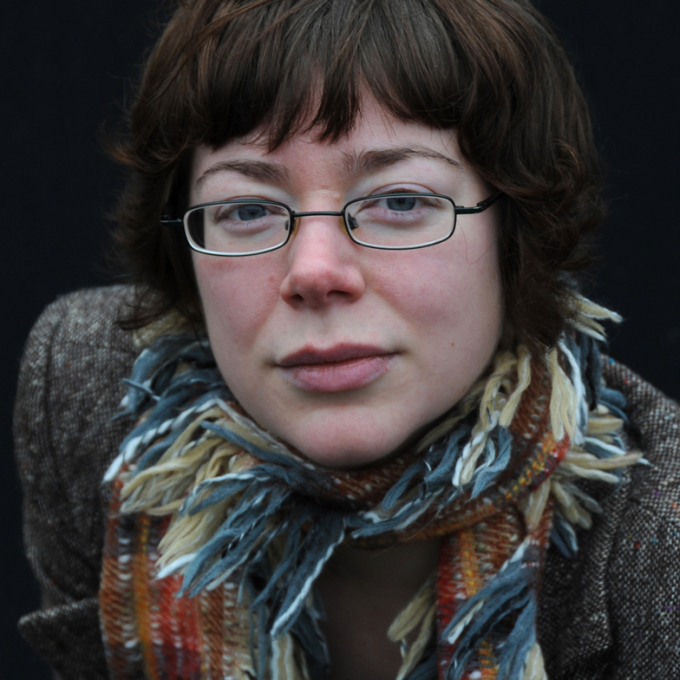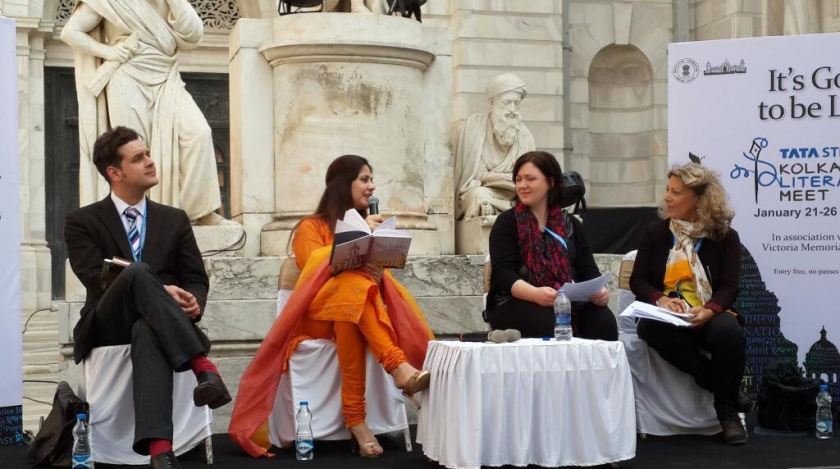
- ©
- Caroline Forbes
Biography
Jen Hadfield was born in Cheshire in 1978, and studied English Language and Literature at the University of Edinburgh. She was later awarded an M Litt (Distinction) from the Universities of Glasgow and Strathclyde.
She is the author of three poetry collections, Almanacs (2005); Nigh-No-Place (2008), shortlisted for the Forward Poetry Prize (Best Poetry Collection of the Year), and winner of the 2008 T. S. Eliot Prize; and Byssus (2014). Her poems are inspired by Shetland, where she lives, and also by her travels across Canada.
Critical perspective
The opening poem of Jen Hadfield’s second collection, Nigh-No-Place (2008), consists of a musical, anaphoric list of offbeat, Narnia-esque place names:
‘I will meet you at Pity Me Wood. / I will meet you at Up-To-No-Good. // I will meet you at Stank, Shank and Stye. / I will meet you at Blowfly’.
As the poem exemplifies, in its fascination with locales, its compulsive list-making, its beguiling lyricism and abiding interest in folklore and fantasy, Hadfield’s poetry is a refreshing and curious mixing pot of creative impulses; evidence of an entirely singular sensibility at work. Her poems combine precise, economic lines with exuberant syntactic and musical play, adopt poetic forms from the prose poem to the prayer, and draw on Brewer’s Dictionary of Phrase & Fable and words from Scots dialect to fully realise the essence of her Shetland home, as well as exploring time spent in Canada, from the ice and tundra of Churchill, Manitoba (uncovering the ‘softmint or astronaut’ of a ‘Prenatal Polar Bear’) to the ‘grey, grey grass of home’ of Alberta (‘Narnia No Moose’). As Roddy Lumsden has stated of Hadfield’s work: ‘She’s a nature poet, but not of the sort that term brings to mind; she’s an experimentalist, but not wilfully or frustratingly so; she’s a storyteller, but is not hung up on or constrained by narrative’. It is this refusal to be pigeonholed or restricted that lends Hadfield’s poetry its charm and edge; her sometimes iconoclastic strategies no doubt informed by her work as a visual artist.
As with all poets, however, certain influences are apparent within Hadfield’s work. In a review in the Times Literary Supplement of her debut collection, Almanacs (2005), for instance, John Greening notes how her poetry possesses ‘something of Gillian Allnutt’s quirky lyricism and a haunted note from George Mackay Brown’. Her poems’ offbeat energy and seemingly boundless inquisitiveness are also reminiscent of Edwin Morgan, while her attention to the minutiae of life and fascination with the remote sometimes remind the reader of Norman MacCaig. But Hadfield’s poetry nonetheless remains wholly her own. Despite this, few critics and prize judges picked up on the promise and originality of Almanacs, perhaps because many of Hadfield’s poems can appear slight and even note-like, are organically arranged into sequences which are more than the sum of their parts and, unlike much contemporary poetry, are borne of an almost Williams-inspired fascination with things rather than ideas. Take the opening stanzas of ‘Staple Island Swing’:
‘What I love – the tall clock of thermals, blackbacksturning on Sunday axles. A guillemot gaping,mouth like a mussel shell. The grooved bright meat.
What I hate – cormorants –when there’s one chick too many, sprawledon the rock like an over-loved fuzzy bear.
What I love – in twos and threes,the cormorants’ greasygreen heraldries.’
Perhaps unsurprisingly, inventive similes abound in Hadfield’s work. These range from the girl dancing with Skerryman, patron saint of Scotland’s bad weather, who is ‘as lanky and lovely as a liquorice bootlace’, to the ‘kidney flinching on a hot griddle, / or very small Hell’s Angel’ of ‘Hedgehog, Hamnavoe’. She also knows her way around a smart extended metaphor, exhibited in ‘Melodeon on the Road Home’ and its conjuring of a friend’s pet as the title’s instrument; ‘good to be hearing your dog’s tune / on the broad curve out of town, / a poem starting, / pattering the breathless little keys’. These poetic devices, along with playful onomatopoeia and alliteration, make the central sequence of Almanacs – ‘a road movie in poems’ called ‘Lorelei’s Lore’ – an invigorating and intensely visual read. Here beauty is found within discord in the landscape – a rotten-looking moon, sheep carcasses, cars sliding down the A970 ‘like loveless beads of rain’ – and even in the innards of creatures: ‘the clean fish and its swimbladder, / like a tigerlily, / on the cutting board’ (‘Song of Parts’). It is this sense of almost Pagan commune with the natural world, alongside the Tarot card titles of some poems (‘XIV Temperance’; ‘III Empress’; ‘XII The Hanged Man’), which lends the book its distinctly liturgical, incantatory flavour. Overall though, Almanacs is a highly personal collection of poems, and one which consequently runs the risk of occasionally losing the reader: what Katy Evans-Bush describes as Hadfield’s ‘powerful commitment to her own affirmative vision’.
Hadfield’s second collection of poems, Nigh-No-Place, was published by Bloodaxe in 2008. In 2009, it was awarded the prestigious T.S. Eliot Prize. As the youngest ever recipient of the award, this brought Hadfield widespread attention, confirming her as one of the most exciting and noteworthy younger voices in contemporary British poetry. The collection itself further develops the themes and styles of Hadfield’s earlier work, including some remarkable sensory studies of place (Shetland, but also Canada, where she began writing the book), a handful of dexterous anaphoric pieces (including ‘Love’s Dog’, which takes a line from Edwin Morgan’s poem ‘A View of Things’ and runs with it), and further vignettes on typically domesticated animals, Hadfield by her own admission ‘intrigued by creatures that do their own thing despite us’. The best of the latter include two poems on horses: ‘Paternoster’, the lord’s prayer as spoken by a draft horse (‘Heal the hoofprint in my heart. / Give us our oats at bedtime / And in the night half-sleeping’), and the imaginative ‘Ladies and Gentleman This Is a Horse as Magritte Might Paint Him’, where a percheron drugged ‘in the climate-controlled hold’ of an aircraft leads the poet to pray ‘may the horse never wake / that stands in mid-air’. Both of these poems succeed given their flickering on the borderline between the spiritual and the secular; admirably reaching to find bridges between the two.
This is something which similarly, though less overtly, infuses a number of poems in Nigh-No-Place that take as their subject poetry itself. In ‘Daed-traa’, for instance, a Shetland dialect term for ‘the slack of the tide’, the poet states how she visits ‘the rockpool […] / to mind me what my poetry’s for’: a place which forms a sort of idiosyncratic, secular church for the poet in its possessing ‘ventricles, just like us’, as well as ‘its theatre – hushed and plush’ and ‘its holy hiccup’. Moreover, in containing water drawn from an expanse of wide-reaching ocean, but at the same time existing as something significantly isolated and local, the rockpool becomes a physical manifestation of Hadfield’s poetic outlook: in her own words, ‘being honest about the present tense that you live in and looking as accurately and intently as possible at one place’. In its attention to detail and imaginative intensity, Nigh-No-Place certainly achieves this, and if Hadfield continues to push her poems beyond their fundamental descriptiveness, consistently asking more of them, she will surely be on to something very special.
Ben Wilkinson, 2009
